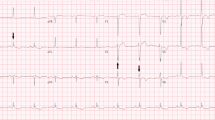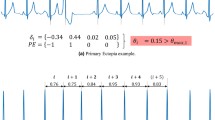Abstract
Background
Impaired cardiac autonomic function has been linked to adverse outcomes in patients with acute coronary syndromes (ACS) but is not included in clinical risk models. This is the first study to investigate whether point-of-care testing of cardiac autonomic function by means of short-term deceleration capacity (DC) of heart rate improves risk assessment in patients with suspected ACS.
Methods
1821 patients with suspected ACS were prospectively enrolled if they were older than 17 years and in sinus rhythm. Short-term DC was automatically assessed from monitor recordings at hospital admission. The Global Registry of Acute Coronary Events (GRACE) score was used as gold standard risk predictor. Primary endpoint was the composite of intrahospital and 30-day mortality. Secondary endpoint was 180-day mortality.
Results
Of the 1,821 patients with suspected ACS, 28 (1.5%) and 60 (3.3%) reached the primary and secondary endpoints, respectively. DC was a highly significant predictor of both endpoints, yielding areas under the curve (AUC) of 0.784 (95% CI 0.714–0.854) and 0.781 (0.727–0.832) (p < 0.001 for both), respectively. Implementing DC into the GRACE-risk model leads to a significant increase of the C-statistics from 0.788 (0.703–0.874) to 0.825 (0.750–0.900; p < 0.01 for difference) and from 0.814 (0.759–0.864) to 0.851 (0.808–0.889; p < 0.01 for difference) for the primary and secondary endpoints, respectively. Stratification by dichotomized DC was especially powerful in patients with GRACE score <140.
Conclusions
In patients with suspected ACS, point-of-care testing of cardiac autonomic function by means of DC is feasible and improves risk assessment by the GRACE score.
Clinical Trial Registration
Clinicaltrials.gov NCT01486589.



Similar content being viewed by others
References
Task Force M, Roffi M, Patrono C, Collet JP, Mueller C, Valgimigli M, Andreotti F, Bax JJ, Borger MA, Brotons C, Chew DP, Gencer B, Hasenfuss G, Kjeldsen K, Lancellotti P, Landmesser U, Mehilli J, Mukherjee D, Storey RF, Windecker S (2015) 2015 ESC Guidelines for the management of acute coronary syndromes in patients presenting without persistent ST-segment elevation: Task Force for the Management of Acute Coronary Syndromes in Patients Presenting without Persistent ST-Segment Elevation of the European Society of Cardiology (ESC). Eur Heart J. doi:10.1093/eurheartj/ehv320
Granger CB, Goldberg RJ, Dabbous O, Pieper KS, Eagle KA, Cannon CP, Van De Werf F, Avezum A, Goodman SG, Flather MD, Fox KA, Global Registry of Acute Coronary Events I (2003) Predictors of hospital mortality in the global registry of acute coronary events. Arch Intern Med 163(19):2345–2353. doi:10.1001/archinte.163.19.2345
Elbarouni B, Goodman SG, Yan RT, Welsh RC, Kornder JM, Deyoung JP, Wong GC, Rose B, Grondin FR, Gallo R, Tan M, Casanova A, Eagle KA, Yan AT, Canadian Global Registry of Acute Coronary Events I (2009) Validation of the Global Registry of Acute Coronary Event (GRACE) risk score for in-hospital mortality in patients with acute coronary syndrome in Canada. Am Heart J 158(3):392–399. doi:10.1016/j.ahj.2009.06.010
Kelly AM, Klim S, Soon K (2015) External validation of the GRACE Freedom from Events score in an emergency department ‘rule out ACS’ chest pain cohort. Int J Cardiol 179:358–359. doi:10.1016/j.ijcard.2014.11.076
Alter DA, Venkatesh V, Chong A, Group SS (2006) Evaluating the performance of the Global Registry of Acute Coronary Events risk-adjustment index across socioeconomic strata among patients discharged from the hospital after acute myocardial infarction. Am Heart J 151(2):323–331. doi:10.1016/j.ahj.2005.07.013
Schaeffer BN, Rybczynski M, Sheikhzadeh S, Akbulak RO, Moser J, Jularic M, Schreiber D, Daubmann A, Willems S, von Kodolitsch Y, Hoffmann BA (2015) Heart rate turbulence and deceleration capacity for risk prediction of serious arrhythmic events in Marfan syndrome. Clin Res Cardiol 104(12):1054–1063. doi:10.1007/s00392-015-0873-9
Bauer A, Barthel P, Schneider R, Ulm K, Muller A, Joeinig A, Stich R, Kiviniemi A, Hnatkova K, Huikuri H, Schomig A, Malik M, Schmidt G (2009) Improved Stratification of Autonomic Regulation for risk prediction in post-infarction patients with preserved left ventricular function (ISAR-Risk). Eur Heart J 30(5):576–583. doi:10.1093/eurheartj/ehn540
Bauer A, Kantelhardt JW, Bunde A, Barthel P, Schneider R, Malik M, Schmidt G (2006) Phase-rectified signal averaging detects quasi-periodicities in non-stationary data. Physica A 364:423–434
Bauer A, Kantelhardt JW, Barthel P, Schneider R, Makikallio T, Ulm K, Hnatkova K, Schomig A, Huikuri H, Bunde A, Malik M, Schmidt G (2006) Deceleration capacity of heart rate as a predictor of mortality after myocardial infarction: cohort study. Lancet 367(9523):1674–1681
Verrier RL, Antzelevitch C (2004) Autonomic aspects of arrhythmogenesis: the enduring and the new. Curr Opin Cardiol 19(1):2–11
Schwartz PJ, La Rovere MT, Vanoli E (1992) Autonomic nervous system and sudden cardiac death. Experimental basis and clinical observations for post-myocardial infarction risk stratification. Circulation 85(1 Suppl):I77–I91
Eick C, Rizas KD, Zuern CS, Bauer A (2014) Automated assessment of cardiac autonomic function by means of deceleration capacity from noisy, nonstationary ECG signals: validation study. Ann Noninvasive Electrocardiol 19(2):122–128. doi:10.1111/anec.12107
Eick C, Rizas KD, Meyer-Zurn CS, Groga-Bada P, Hamm W, Kreth F, Overkamp D, Weyrich P, Gawaz M, Bauer A (2015) Autonomic nervous system activity as risk predictor in the medical emergency department: a prospective cohort study. Crit Care Med 43(5):1079–1086. doi:10.1097/CCM.0000000000000922
Lian J, Wang L, Muessig D (2011) A simple method to detect atrial fibrillation using RR intervals. Am J Cardiol 107(10):1494–1497. doi:10.1016/j.amjcard.2011.01.028
Bauer A, Kantelhardt JW, Bunde A, Malik M, Schneider R, Schmidt G (2006) Phase-rectified signal averaging detects quasi-periodicities in non-stationary data. Physica A 364:423–434
Eick C, Rizas KD, Zuern CS, Bauer A (2013) Automated assessment of cardiac autonomic function by means of deceleration capacity from noisy, nonstationary ECG signals: validation study. Ann Noninvasive Electrocardiol. doi:10.1111/anec.12107
Kleiger RE, Miller JP, Krone RJ, Bigger JT Jr (1990) The independence of cycle length variability and exercise testing on predicting mortality of patients surviving acute myocardial infarction. The Multicenter Postinfarction Research Group. Am J Cardiol 65(7):408–411
La Rovere MT, Bigger JT Jr, Marcus FI, Mortara A, Schwartz PJ (1998) Baroreflex sensitivity and heart-rate variability in prediction of total cardiac mortality after myocardial infarction. ATRAMI (Autonomic Tone and Reflexes After Myocardial Infarction) Investigators. Lancet 351(9101):478–484
Schroeder J, Hamada S, Grundlinger N, Rubeau T, Altiok E, Ulbrich K, Keszei A, Marx N, Becker M (2016) Myocardial deformation by strain echocardiography identifies patients with acute coronary syndrome and non-diagnostic ECG presenting in a chest pain unit: a prospective study of diagnostic accuracy. Clin Res Cardiol 105(3):248–256. doi:10.1007/s00392-015-0916-2
Hillinger P, Twerenbold R, Wildi K, Rubini Gimenez M, Jaeger C, Boeddinghaus J, Nestelberger T, Grimm K, Reichlin T, Stallone F, Puelacher C, Sabti Z, Kozhuharov N, Honegger U, Ballarino P, Miro O, Denhaerynck K, Ekrem T, Kohler C, Bingisser R, Osswald S, Mueller C (2017) Gender-specific uncertainties in the diagnosis of acute coronary syndrome. Clin Res Cardiol 106(1):28–37. doi:10.1007/s00392-016-1020-y
Davis M, Diamond J, Montgomery D, Krishnan S, Eagle K, Jackson E (2015) Acute coronary syndrome in young women under 55 years of age: clinical characteristics, treatment, and outcomes. Clin Res Cardiol 104(8):648–655. doi:10.1007/s00392-015-0827-2
Bonnemeier H, Hartmann F, Wiegand UK, Irmer C, Kurz T, Tolg R, Katus HA, Richardt G (2000) Heart rate variability in patients with acute myocardial infarction undergoing primary coronary angioplasty. Am J Cardiol 85(7):815–820
Bonnemeier H, Wiegand UK, Friedlbinder J, Schulenburg S, Hartmann F, Bode F, Katus HA, Richardt G (2003) Reflex cardiac activity in ischemia and reperfusion: heart rate turbulence in patients undergoing direct percutaneous coronary intervention for acute myocardial infarction. Circulation 108(8):958–964. doi:10.1161/01.CIR.0000085072.19047.D8
Sade E, Aytemir K, Oto A, Nazli N, Ozmen F, Ozkutlu H, Tokgozoglu L, Aksoyek S, Ovunc K, Kabakci G, Ozer N, Kes S (2003) Assessment of heart rate turbulence in the acute phase of myocardial infarction for long-term prognosis. Pacing and clinical electrophysiology. PACE 26(2 Pt 1):544–550
Fox KA, Dabbous OH, Goldberg RJ, Pieper KS, Eagle KA, Van de Werf F, Avezum A, Goodman SG, Flather MD, Anderson FA Jr, Granger CB (2006) Prediction of risk of death and myocardial infarction in the six months after presentation with acute coronary syndrome: prospective multinational observational study (GRACE). Bmj 333(7578):1091. doi:10.1136/bmj.38985.646481.55
Amsterdam EA, Wenger NK, Brindis RG, Casey DE, Jr., Ganiats TG, Holmes DR, Jr., Jaffe AS, Jneid H, Kelly RF, Kontos MC, Levine GN, Liebson PR, Mukherjee D, Peterson ED, Sabatine MS, Smalling RW, Zieman SJ, Members AATF, Society for Cardiovascular A, Interventions, the Society of Thoracic S (2014) 2014 AHA/ACC guideline for the management of patients with non-ST-elevation acute coronary syndromes: executive summary: a report of the American College of Cardiology/American Heart Association Task Force on Practice Guidelines. Circulation 130(25):2354–2394. doi:10.1161/CIR.0000000000000133
Steg PG, Goldberg RJ, Gore JM, Fox KA, Eagle KA, Flather MD, Sadiq I, Kasper R, Rushton-Mellor SK, Anderson FA, Investigators G (2002) Baseline characteristics, management practices, and in-hospital outcomes of patients hospitalized with acute coronary syndromes in the Global Registry of Acute Coronary Events (GRACE). Am J Cardiol 90(4):358–363
Pedersen OD, Abildstrom SZ, Ottesen MM, Rask-Madsen C, Bagger H, Kober L, Torp-Pedersen C, Investigators TS (2006) Increased risk of sudden and non-sudden cardiovascular death in patients with atrial fibrillation/flutter following acute myocardial infarction. Eur Heart J 27(3):290–295. doi:10.1093/eurheartj/ehi629
Author information
Authors and Affiliations
Corresponding author
Ethics declarations
Conflict of interest
None.
Additional information
K. D. Rizas and A. Bauer contributed equally to this work.
Rights and permissions
About this article
Cite this article
Eick, C., Duckheim, M., Groga-Bada, P. et al. Point-of-care testing of cardiac autonomic function for risk assessment in patients with suspected acute coronary syndromes. Clin Res Cardiol 106, 686–694 (2017). https://doi.org/10.1007/s00392-017-1104-3
Received:
Accepted:
Published:
Issue Date:
DOI: https://doi.org/10.1007/s00392-017-1104-3




